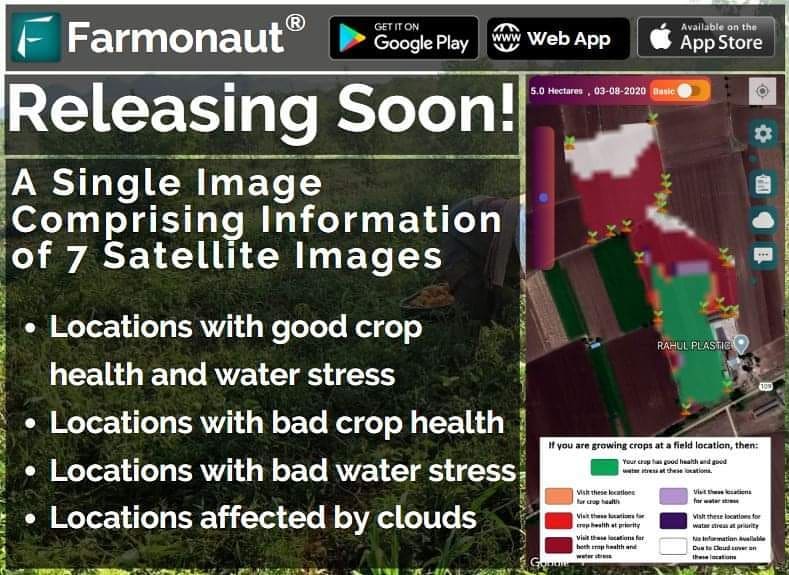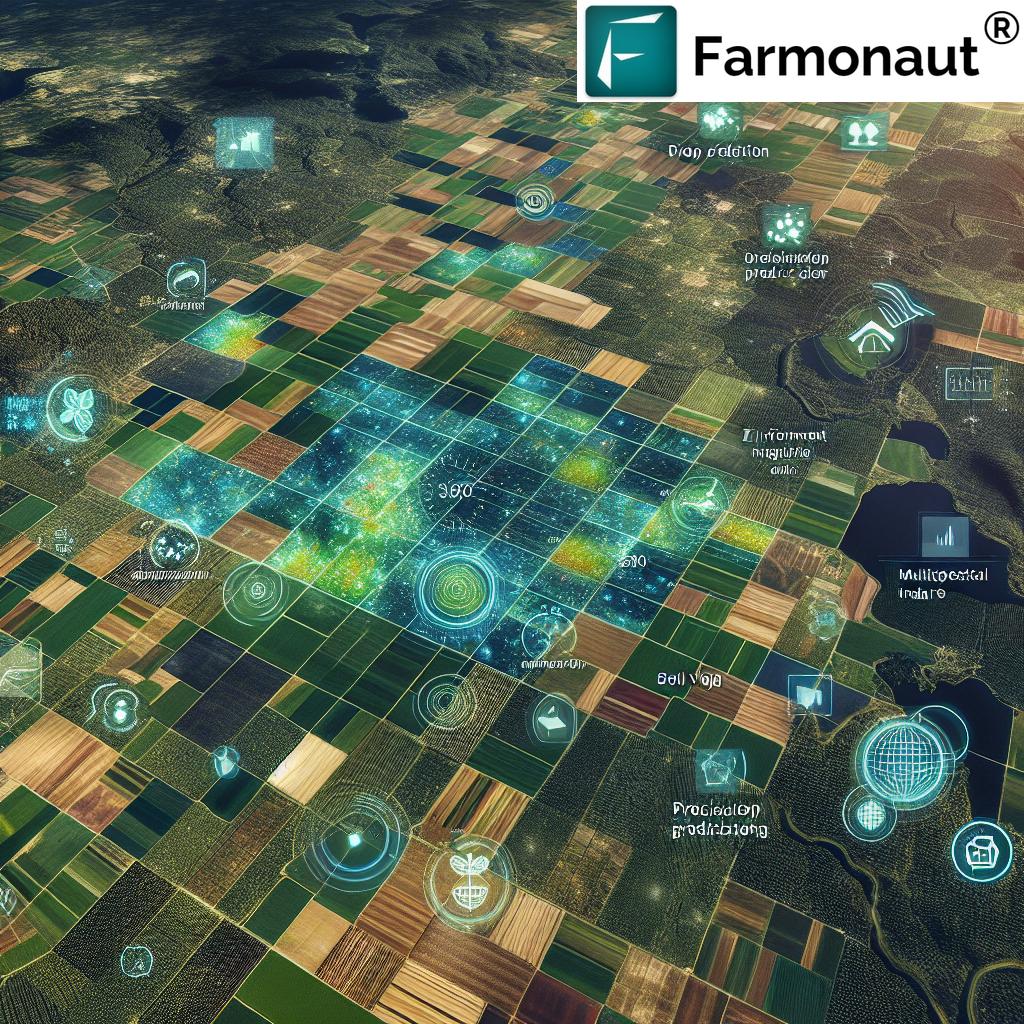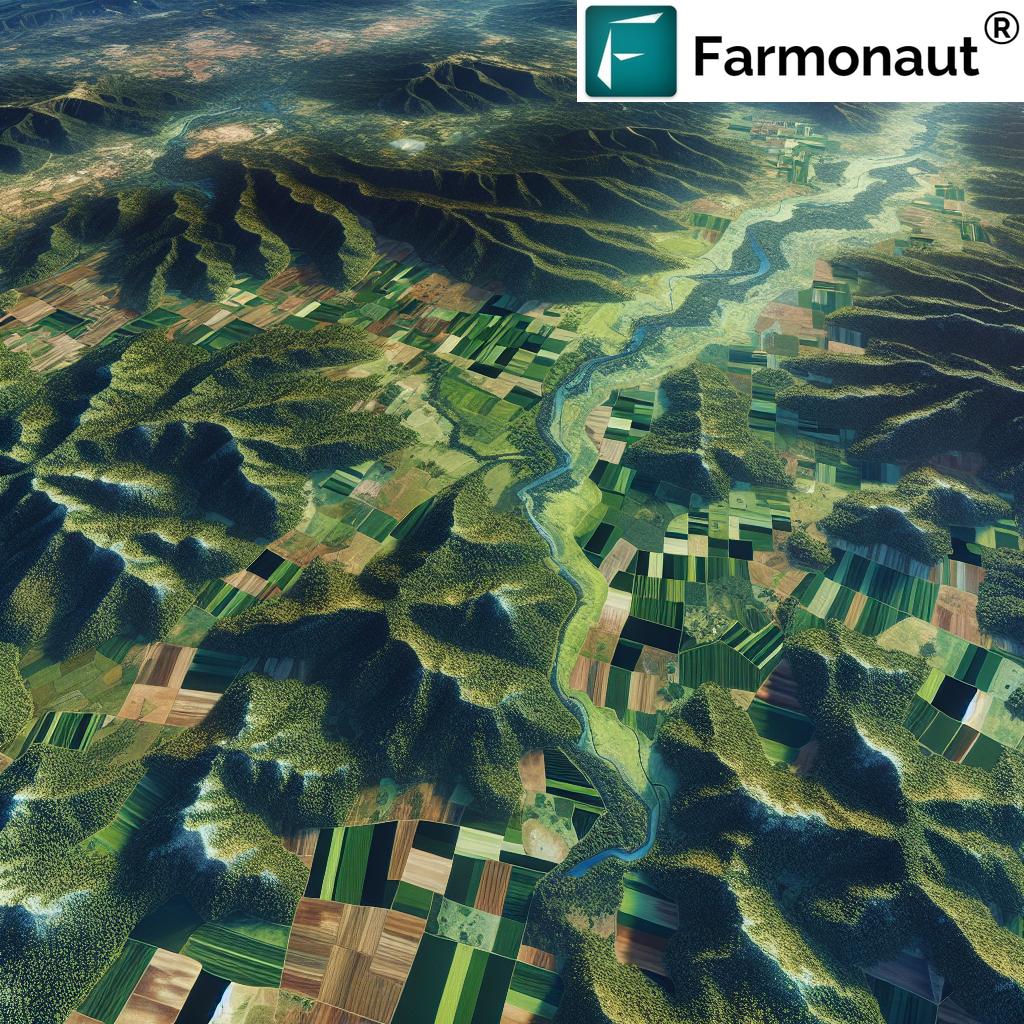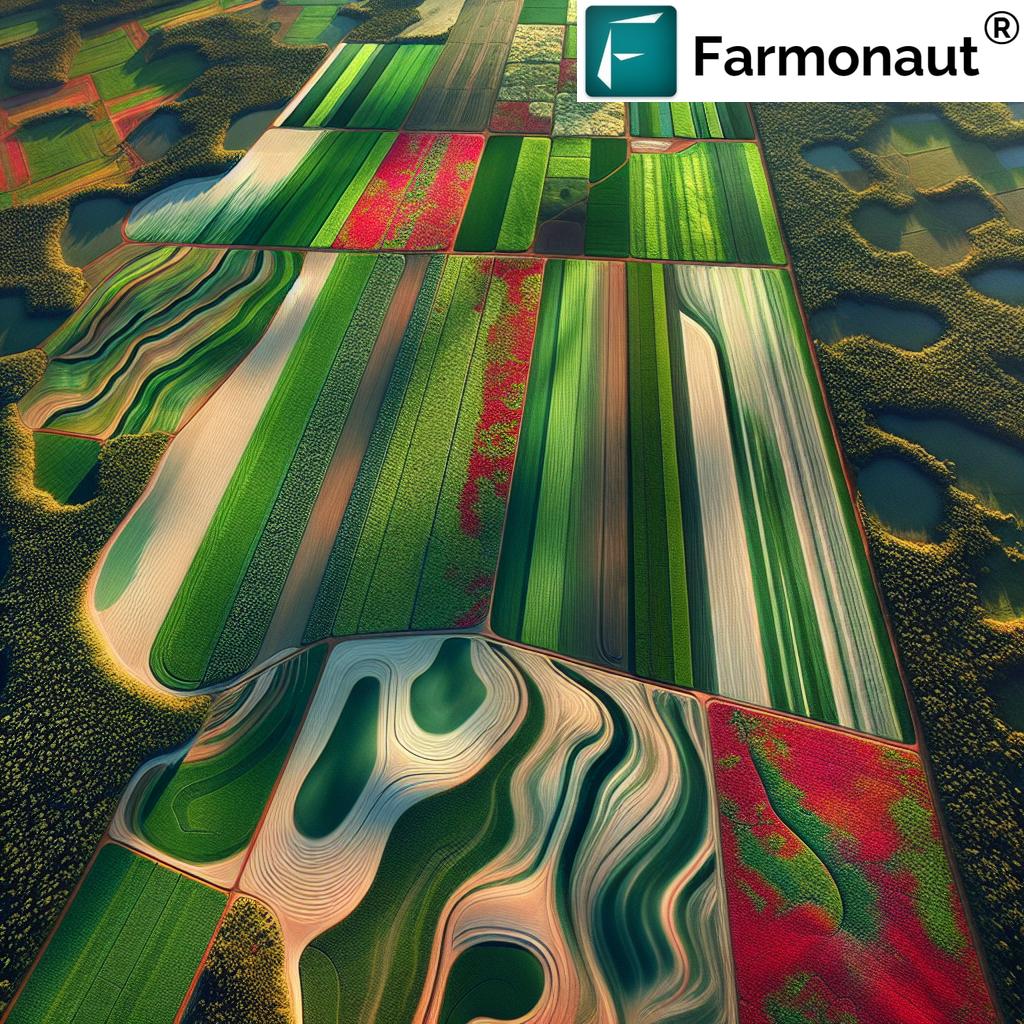Table of Contents
- Introduction
- Understanding InSAR Technology & Ground Movement Monitoring
- Why Access to InSAR Ground Movement Data Matters in 2025
- How to Access InSAR Ground Movement Data for Any Project Size
- Comparison Table of InSAR Data Access Options by Project Size
- How Farmonaut Empowers Projects of All Sizes
- InSAR Ground Movement Data Applications Across Sectors
- Cost and Project Size Considerations
- Looking Ahead: The Future of Accessible InSAR Technology
- How to Access InSAR and Satellite Data Effortlessly with Farmonaut
- FAQ: How to Access InSAR Ground Movement Data for Any Project Size
- Farmonaut Subscription Options
- Conclusion
“In 2025, InSAR satellites can detect ground movement as small as 1 millimeter across projects of any size.”
Access InSAR Ground Movement Data: Any Project Size
How to Access InSAR Ground Movement Data for Any Project Size in 2025
How to Access InSAR Ground Movement Data for Any Project Size is a critical topic for organizations invested in the future of data-driven project management, risk mitigation, and sustainable development. As of 2025, Interferometric Synthetic Aperture Radar (InSAR) technology has revolutionized the way we monitor ground movement. Whether you manage a small farm, forestry plot, infrastructure project, or a large mining or defense operation, you can now access highly accurate, timely, and affordable ground movement insights that directly support your critical operations.
In this comprehensive guide, we explain the process, platforms, and best practices for accessing InSAR ground movement data for any project size in 2025. You’ll discover the technology, data sources, tools, practical steps, and emerging innovations pushing the boundaries of ground movement monitoring—all while keeping pace with rapidly evolving satellite and radar advancements.
Focus Keywords: How to Access InSAR Ground Movement Data for Any Project Size, data, insar, ground, mining, projects, movement, infrastructure, project, monitoring, access, management, satellite, commercial, 2025, radar, small, like, needs, providers, platforms, tools, processing, size, agriculture, large, subsidence, resolution, space, operations, free, leverage, forestry, technology, accessible, affordable, farms, sustainable, understanding, area, sites, rely, deformation, revisit, times, capella, accessing, across, frequent, even, provide, needing, offer, cloud, analysis, teams, software, expertise, requires, insights, interpretation, interferometric, synthetic, aperture, revolutionized, way, monitor, providing, highly, accurate, supports, diverse, applications, defense, become, empowering, harness, benefits, risk, mitigation, relevance, uses, signals, measure, subtle, displacements, comparing, multiple, images, captured, time, technique, detect, movements, caused, land, tectonic, shifts, activities, natural, phenomena, context, instance, invaluable, around, underground, enabling, early, detection, potential, hazards, collapse, instability, similarly, dams, roads, pipelines, assess, prevent, costly, failures, matters, improvements, proliferation, satellites, nisar, constellations, faster, ever, democratization, allows, forest, plot, incorporate, precise, processes, steps, 1, define, scope, tapping, clarify, duration, may, require, deep, might, opt, airborne, systems, 2
Quick Access: Farmonaut API Developer Documentation
Understanding InSAR Technology & Ground Movement Monitoring
What is Interferometric Synthetic Aperture Radar (InSAR)?
Interferometric Synthetic Aperture Radar (InSAR) is an advanced satellite-based radar technique that measures ground surface movement by analyzing the phase difference between radar signals from multiple images taken over the same area and at different times. By comparing these radar images (captured at regular intervals, or revisit times), InSAR can detect subtle ground displacements—even as small as 1 millimeter—caused by various human activities (like mining, construction) and natural phenomena (like earthquakes, subsidence, or volcanic shifts).
How Does InSAR Monitor Ground Movement?
The InSAR process involves sending radar signals from satellites (like Sentinel-1, NISAR, Capella Space, and others) to the Earth’s surface. When these signals bounce back, the satellite captures multiple radar images from different times, creating a time series of the same location. By measuring phase changes in the backscattered waves, InSAR technology can detect, map, and quantify ground movement with high accuracy.
- Highly Accurate: InSAR delivers movement detection at the scale of only a few millimeters—making it a go-to solution for sensitive ground monitoring projects.
- Large-Scale Monitoring: One pass of a modern SAR satellite can cover hundreds of square kilometers, allowing even small farms, forest plots, or localized infrastructure sites to benefit alongside large mining or city-wide projects.
- Frequent Updates: With improvements in satellite revisit times (down to days or even hours), projects can monitor ground movement nearly in real time.
In summary, InSAR revolutionized the way we monitor and manage ground deformation across diverse sectors—supporting agriculture, mining, infrastructure, forestry, and defense applications.
Main Applications of InSAR Ground Movement Data
- Agriculture: Monitor soil stability, irrigation-driven subsidence, or damage to agricultural infrastructure.
- Mining: Detect subsidence, collapse risk, and ground stability at open-pit and underground mining sites.
- Infrastructure Projects: Assess deformation and potential failures in dams, bridges, pipelines, and urban areas.
- Forestry Management: Track ground shifts in forested and conservation lands for ecosystem stability.
- Defense & Intelligence: Support situational awareness by monitoring surface changes in sensitive regions.
Why Access to InSAR Ground Movement Data Matters in 2025
The significance of accessing InSAR ground movement data—regardless of project size—continues to grow in 2025 and beyond. Here’s why:
- Technological Leap: New satellites like Sentinel-1, NISAR (NASA-ISRO Synthetic Aperture Radar), and commercial constellations such as Capella Space are delivering higher-resolution, more frequent radar images at costs affordable to virtually all scales of projects.
- Proliferation of Providers and Platforms: The democratization of InSAR data means small farms, regional infrastructure sites, and large mining operations can all incorporate ground movement insights into decision-making.
- Cloud Processing: Modern cloud-based platforms and user-friendly tools mean you don’t need a team of remote sensing experts or high-powered servers to analyze your project’s InSAR results.
- Risk Management and Sustainability: With extreme weather events and geotechnical hazards rising globally, ongoing monitoring is essential for sustainable management and safety.
“Over 1,000 global projects will use advanced InSAR radar for ground monitoring and risk mitigation in 2025.”
How to Access InSAR Ground Movement Data for Any Project Size: Step-by-Step Guide
Gaining actionable, reliable InSAR ground movement data can streamline management, monitoring, and risk mitigation for a variety of projects. The process is straightforward but requires understanding your specific project needs and available technology options.
Step 1: Define Your Project’s Scope and Needs
- Clarify the Project Area: Determine the specific area (in sq. km or hectares) where ground movement needs to be monitored.
- Duration and Frequency: Decide how often you need new data (weekly, monthly, daily) based on risk profiles and operational schedules.
- Resolution Requirements: Smaller, high-risk sites (e.g., dam walls or active mining faces) may need high-resolution, frequent revisit times. Larger, lower-risk regions (e.g., extensive farmlands, forests) might be monitored less often at coarser resolution.
- Ground Truth Integration: Assess the value of combining InSAR with field observations (GPS, visual inspections) for validation and supplemental insights.
Example: A small dairy farm may prioritize cost-effective, monthly InSAR updates for land subsidence. Meanwhile, a national highway project may require weekly, high-resolution monitoring along the entire route.
Step 2: Choose the Appropriate Data Source
InSAR satellite missions are conducted by both public agencies and commercial entities, offering varied data resolution, revisit time, and cost structures. Key InSAR data providers include:
Public (Open-Source) Satellite Data
- Sentinel-1 (ESA): Provides free, open-access SAR data with regular revisit times, suitable for most small to medium projects needing monthly to biweekly monitoring.
- NISAR (NASA-ISRO): Expected to offer highly accurate SAR data with global coverage and improved repeat cycles for mainstream ground monitoring applications starting early 2025.
Access Sentinel-1 data easily through cloud platforms or Copernicus Open Access Hub.
Commercial Satellite Constellations
- Capella Space, ICEYE, BlackSky: Offer on-demand, high-resolution SAR data with flexible revisit times (as frequent as multiple times per day) and tailored packages for large, high-stakes projects.
- Purchase data directly or via authorized platforms for quick turnaround and custom tasking over your site of interest.
Commercial InSAR data is ideal for mining, defense, or critical infrastructure projects where detailed, real-time ground movement insights are necessary.
Government and Research Collaborations
- Certain institutions, NGOs, and governments offer subsidized or collaborative InSAR data solutions for sectors like disaster management, urban security, or national infrastructure.
Step 3: Utilize Cloud-Based Platforms and Tools
Cloud platforms simplify satellite and InSAR data access, analysis, and visualization for all project sizes. In 2025, no local processing hardware is needed, as web-based services provide cost-effective solutions:
- Google Earth Engine: Allows processing of Sentinel-1 InSAR datasets directly within your browser. Build custom scripts or use shared libraries for common ground movement analysis tasks.
- Alaska Satellite Facility’s Vertex: Another interface for open SAR data access and automated processing workflows.
- Commercial Dashboards: Farmonaut’s Web & Mobile Platforms provide real-time monitoring, AI-driven analysis, and easy visualization for end users—serving agriculture, mining, and infrastructure projects worldwide.
Cloud platforms make InSAR technology truly accessible and affordable—empowering small teams and large operations alike.
Step 4: Leverage Specialized Software and Expertise
Interpreting raw InSAR radar data isn’t trivial—it requires expertise and often, dedicated software. Key options include:
- SNAP (Sentinel Application Platform): ESA’s open-source toolkit for processing Sentinel-1 SAR data and basic ground movement analysis. Well suited for researchers or technical teams.
- Commercial software: Suites like GAMMA, SARPROZ, and ESRI’s ArcGIS bring advanced analysis options, visualizations, and integration with existing GIS pipelines.
- Third-party service providers: For organizations without in-house remote sensing expertise, consider reliable providers that can process, interpret, and report actionable InSAR insights.
Farmonaut’s Jeevn AI Advisory System seamlessly integrates satellite-based InSAR analytics and delivers tailored recommendations for agriculture, mining, and infrastructure management via web, API, and mobile apps.
Step 5: Integrate InSAR Data with On-Ground Observations
While InSAR delivers precise, spatially extensive ground movement monitoring, integration with traditional field surveys, GPS, geological mapping, and local sensors further improves reliability.
- Combine: Use GPS stations at critical sites for continuous ground truth validation of InSAR results.
- Correlate: Compare satellite-derived deformation maps with direct field observations to identify and address any anomalies.
- Contextualize: Use on-ground insights to interpret InSAR-detected movement within the actual project context (e.g., structural changes, rainfall, mining explosions).
Comparison Table of InSAR Ground Movement Data Access Options by Project Size
| Project Size | Estimated Area Covered (sq. km) | Data Access Frequency | Turnaround Time (days) | Estimated Cost (USD) | Key Applications |
|---|---|---|---|---|---|
| Small (e.g., small farms, local infra sites) | 1–100 | Monthly, Biweekly | 1–3 | Free–$499/year | Localized risk monitoring, crop health, small infrastructure safety, subsidence |
| Medium (e.g., forestry, mid mining ops) | 100–5,000 | Biweekly, Weekly | 1–7 | $500–$5,000/year | Regional risk mitigation, sustainability, forest management, medium mining |
| Large (e.g., national mining, infrastructure) | 5,000–50,000+ | Weekly, On-Demand, Real-time | 1–2 | $5,000–$50,000+/year | Nation-wide risk mitigation, disaster response, critical infrastructure, mining |
How Farmonaut Empowers Projects of All Sizes to Harness InSAR Technology in 2025
At Farmonaut, our mission is to make satellite-driven insights affordable and accessible for all sizes of agriculture, mining, infrastructure, forestry, and defense projects. We provide a comprehensive platform that blends:
- Multispectral satellite imagery—delivering crop health, soil metrics, environmental status, and site integrity data.
- AI advisory (Jeevn System): Automated recommendations across resource management, risk alerts, and operational optimization.
- Blockchain traceability: Supply chain authenticity and product verification (learn more about our Traceability tools).
- Fleet management modules: Integrated solutions for machinery logistics and operational efficiency (optimize your fleet with Farmonaut).
- Environmental impact monitoring: Actionable carbon and resource data for compliance and sustainability (see our carbon footprint tracking).
Our platform is modular and scalable—helping both smallholders and large enterprises leverage satellite and ground movement insights.
How to Access InSAR Ground Movement Data for Any Project Size: Sector Applications
Agriculture & Forestry
- Soil Subsidence Detection: Early warning for irrigated or organic-rich farmland subsidence (enabling more precise irrigation or drainage planning).
- Forest Plot Stability: Analysis of ground shifts from root systems, seasonal hydrology, or infrastructure encroachment (see our forest advisory platform).
- Disaster Monitoring: Monitor the impact of floods, landslides, or droughts on cropland and natural vegetation.
Mining Operations
- Subsidence & Collapse Prevention: Detect ground deformation around underground and open-pit mining sites, revealing early signs of instability, collapse, or operational risk management needs.
- Environmental Compliance: Map post-extraction effects and plan for sustainable land restoration.
- Loan & Insurance: Support satellite-based verification for crop loan and insurance and mining project viability reviews.
Infrastructure & Construction
- Dams, Roads, Pipelines: Continuous monitoring of infrastructure movement to detect subsidence, ground instability, and prevent costly failures.
- Urban and Regional Planning: Identify tectonic or natural trends for sustainable expansion and disaster prevention.
- Fleet Management: Enable real-time resource, asset, and vehicle tracking for large-scale operations.
Defense and Disaster Response
- Situational Intelligence: Monitor surface movement in sensitive zones, border areas, and disaster-affected sites.
- Infrastructure Protection: Detect sabotage or natural threat-related deformation as part of integrated defense intelligence.
Cost and Project Size Considerations
The cost of accessing InSAR ground movement data varies by project size, data resolution, revisit frequency, and need for expert interpretation. Here’s how costs typically break down in 2025:
- Small Projects (e.g., small farms, minor infrastructure): Leverage free Sentinel-1 data using cloud platforms, with minimal costs for software or periodic expert consultations.
- Medium Projects (regional forestry, mining): Combine free open-access data for broad areas with periodic purchases of high-resolution, commercial imagery. Investing in in-house analysts and software is often justified.
- Large Projects (national infrastructure, large mines): Opt for commercial constellations (Capella, ICEYE, etc.) and regular “on-demand” monitoring, backed by dedicated teams for continuous, real-time risk assessment and response. Budgets scale into thousands of USD, but offer superior operational security and disaster prevention.
Across all scales, the return on investment from averting costly failures, regulatory breaches, or environmental disasters can be significant.
Looking Ahead: The Future of Accessible InSAR Technology
- AI-Driven Automation: Cloud-based, AI-assisted platforms can now automatically identify, report, and visualize ground movement—making interpretation accessible even to non-specialists.
- Blockchain Traceability: As utilized by Farmonaut, blockchain ensures traceability and verification for agricultural, mining, and supply chain management (more about Farmonaut’s Traceability solutions).
- Environmental & Carbon Impact: Real-time satellite monitoring supports regulatory compliance and sustainable operations (carbon footprint monitoring explained).
- APIs and DEMO Environments: Seamless integration and web-access—see the Farmonaut demo portal for a hands-on preview, or utilize our powerful API for advanced users and developers.
How to Access InSAR and Satellite Data Effortlessly with Farmonaut’s Tools & Apps
We at Farmonaut provide a seamless experience to access InSAR ground movement data for any project size via web, Android, iOS, and API interfaces:
- Web and Mobile Apps: Instantly monitor plots, get actionable AI insights, and visualize satellite-based metrics on the Farmonaut platform.
- API Integration: For developers and enterprise users, the Farmonaut Satellite Data API and developer docs allow integration of advanced InSAR, weather, and resource datasets into custom dashboards and workflows.
- AI Advisory Tools: The Jeevn AI system provides real-time advisory across agriculture, mining, and infrastructure, supporting precision management and risk mitigation.
- Blockchain and Traceability: Secure, end-to-end tracking and validation for crops, resources, and commodities.
- Resource & Fleet Management: Enhance operational efficiency and sustainability in daily field operations or large fleets—even across remote regions.
Our solutions support cost-effective, sustainable management for businesses, users, and government agencies worldwide.
Ready to get started? Access Farmonaut Web App now!
FAQ: How to Access InSAR Ground Movement Data for Any Project Size
Q1. What is InSAR and how is it used for ground movement monitoring?
Answer: InSAR, or Interferometric Synthetic Aperture Radar, utilizes satellite radar signals to detect millimeter-level ground movements by comparing multiple images over time. It’s widely used in agriculture, mining, infrastructure, and defense for risk mitigation and project management.
Q2. How can small projects or farms access InSAR ground movement data affordably?
Answer: Small projects can use free Sentinel-1 data via cloud tools like Google Earth Engine or platforms such as Farmonaut’s web, Android, and iOS apps, making advanced monitoring accessible and affordable.
Q3. Which providers offer commercial, high-resolution InSAR data in 2025?
Answer: Key commercial providers include Capella Space, ICEYE, and BlackSky, offering high-resolution SAR data with rapid revisit times for deep or large-scale project monitoring.
Q4. What are the benefits of integrating InSAR data with on-ground observations?
Answer: Integration improves accuracy; on-ground sensors and GPS validate satellite observations, ensuring reliable, context-driven decisions for risk management.
Q5. Can I process InSAR data without deep technical expertise?
Answer: Yes—many platforms (like Farmonaut), as well as third-party providers, offer end-to-end processing, visualization, and advisory solutions. Technical users may opt for SNAP or GAMMA software if needed.
Q6. Are Farmonaut solutions scalable for both small and large projects?
Answer: Absolutely! The Farmonaut platform is modular and can be tailored to fit the requirements of a single user or cover vast national operations across agriculture, mining, and infrastructure.
Farmonaut Subscription Options
Ready to leverage the full power of InSAR, AI, and cloud-based data tools for project management, monitoring, and sustainability?
Conclusion: The Democratization of InSAR Ground Movement Data Access in 2025
How to Access InSAR Ground Movement Data for Any Project Size in 2025 is no longer a challenge. The proliferation of high-resolution satellites, public and commercial data sources, cloud processing platforms, and user-friendly tools places advanced ground movement monitoring within reach for all projects—small, medium, or large.
Farmonaut empowers us to bridge the technology gap: bringing accessible, affordable satellite-based solutions to agriculture, mining, infrastructure, and environmental management worldwide. Organizations can now monitor risks, optimize resources, and advance sustainability goals with practical, real-time ground movement insights—driven by the latest in InSAR, AI, and satellite radar technology.
Get started now: Access the Farmonaut Web App or explore the Farmonaut API for hands-on, innovative ground monitoring for any project size.
Stay at the forefront of technology & innovation in 2025—and make data your most powerful asset in sustainable project management.














